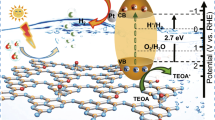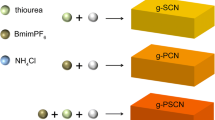Abstract
In this study, the porous ultrathin graphitic carbon nitride (CN) nanosheets with rich C and nitrogen defects were prepared by one-step calcining the mixture of melamine and glucose (Glu) in air atmosphere (Glu-CN). Introducing simultaneously rich C atoms and nitrogen defects into CN structures continuously modulates the bandgaps from 2.67 to 1.81 eV of CN photocatalysts. Due to large surface area, more active sites, remarkably longer lifetime of charge carriers and adjustable band gap structure, the prepared ultrathin porous CN nanosheets show the enhanced photocatalytic performance for the degradation of methyl orange (MO) under visible light. The degradation efficiency of optimal CN nanosheet photocatalyst for MO is 5.75 times that of bulk CN. This work provides a facile and universal relevance approach to engineer the band structures of CN by introduction of rich C and porous morphology for high-performance photocatalytic, which can provide informative principles for the design of efficient photocatalysis systems for solar energy conversion.
Graphic Abstract













Similar content being viewed by others
References
Feng C, Tang L, Deng Y, Wang J, Luo J, Liu Y, Ouyang X, Yang H, Yu J, Wang J (2020) Synthesis of leaf-vein-like g-C3N4 with tumble band structures and charge transfer properties for selective photocatalytic H2O2 evolution. Adv Funct Mater 30(39):1–13
Liang Q, Li Z, Huang ZH, Kang F, Yang QH (2015) Holey graphitic carbon nitride nanosheets with carbon vacancies for highly improved photocatalytic hydrogen production. Adv Funct Mater 25(44):6885–6892
Li Y, Yang M, Xing Y, Liu X, Yang Y, Wang X, Song S (2017) Preparation of carbon-rich g-C3N4 nanosheets with enhanced visible light utilization for efficient photocatalytic hydrogen production. Small 13(33):1–8
Ran J, Zhang J, Yu J, Jaroniec M, Qiao SZ (2014) Earth-abundant cocatalysts for semiconductor-based photocatalytic water splitting. Chem Soc Rev 43(22):7787–7812
Qu Y, Duan X (2013) Progress, challenge and perspective of heterogeneous photocatalysts. Chem Soc Rev 42(7):2568–2580
Jinshui Z, Wang Bo WX (2014) Carbon nitride polymeric semiconductor for photocatalysis. Prog Chem 26(1):19–29
Jun YS, Lee EZ, Wang X, Hong WH, Stucky GD, Thomas A (2013) From melamine-cyanuric acid supramolecular aggregates to carbon nitride hollow spheres. Adv Funct Mater 23(29):3661–3667
Wan G, Fu Y, Guo J, Xiang Z (2015) Photoelectronic porous covalent organic materials: research progress and perspective. Acta Chim Sinica 73(6):557–578
Kudo A, Miseki Y (2009) Heterogeneous photocatalyst materials for water splitting. Chem Soc Rev 38(1):253–278
Mishra A, Mehta A, Basu S, Shetti NP, Reddy KR, Aminabhavi TM (2019) Graphitic carbon nitride (g-C3N4)-based metal-free photocatalysts for water splitting: a review. Carbon 149:693–721
Maeda K, Domen K (2010) Photocatalytic water splitting: recent progress and future challenges. J Phys Chem Lett 1(18):2655–2661
Hoffmann MR, Martin ST, Choi W, Bahnemann DW (1995) Environmental applications of semiconductor photocatalysis. Chem Rev 95(1):69–96
Fox MA, Dulay MT (1993) Heterogeneous photocatalysis. Chem Rev 93(1):341–357
Chen X, Shen S, Guo L, Mao SS (2010) Semiconductor-based photo catalytic hydrogen generation. Chem Rev 110(11):6503–6570
Osterloh FE (2008) Inorganic materials as catalysts for photochemical splitting of water. Chem Mater 20(1):35–54
Schneider J, Matsuoka M, Takeuchi M, Zhang J, Horiuchi Y, Anpo M, Bahnemann DW (2014) TiO2 photocatalysis: mechanisms and materials. Chem Rev 114(19):9919–9986
Zhao Z, Sun Y, Dong F (2015) Graphitic carbon nitride based nano composites: a review. Nanoscale 7(1):15–37
Iqbal W, Qiu B, Zhu Q, Xing M, Zhang J (2018) Self-modified breaking hydrogen bonds to highly crystalline graphitic carbon nitrides nanosheets for drastically enhanced hydrogen production. Appl Catal B-Environ 232(3):306–313
Cheng L, Zhang H, Li X, Fan J, Xiang Q (2021) Carbon-graphitic carbon Nitride hybrids for heterogeneous photocatalysis. Small 17(1):1–22
Adekoya D, Zhang S, Hankel M (2021) Boosting reversible lithium storage in two-dimensional C3N4 by achieving suitable adsorption energy via Si doping. Carbon 176:480–487
He L, Zhang XQ, Lu AH (2017) Two-dimensional carbon-based porous materials: synthesis and applications. Acta Phys-Chim Sin 33(4):709–728
Wang Y, Silveri F, Bayazit MK, Ruan Q, Li Y, Xie J, Catlow CRA, Tang J (2018) Bandgap engineering of organic semiconductors for highly efficient photocatalytic water splitting. Adv Energy Mater 8(24):1–10
Zhao D, Dong CL, Wang B, Chen C, Huang YC, Diao Z, Li S, Guo L, Shen S (2019) Synergy of dopants and defects in graphitic carbon nitride with exceptionally modulated band structures for efficient photocatalytic oxygen evolution. Adv Mater 31(43):1–10
Zhang J, Chen J, Wan Y, Liu H, Chen W, Wang G, Wang R (2020) Defect engineering in atomic-layered graphitic carbon nitride for greatly extended visible-light photocatalytic hydrogen evolution. ACS Appl Mater Interfaces 12(12):13805–13812
Zhu D, Zhou Q (2021) Nitrogen doped g-C3N4 with the extremely narrow band gap for excellent photocatalytic activities under visible light. Appl Catal B-Environ 281(1):119474
Deng P, Xiong J, Lei S, Wang W, Ou X, Xu Y, Xiao Y, Cheng B (2019) Nickel for mate induced high-level: in situ Ni-doping of g-C3N4 for a tunable band structure and enhanced photocatalytic performance. J Mater Chem A 7(39):22385–22397
Liu J, Yu Y, Qi R, Cao C, Liu X, Zheng Y, Song W (2019) Enhanced electron separation on in-plane benzene-ring doped g-C3N4 nanosheets for visible light photocatalytic hydrogen evolution. Appl Catal B-Environ 244:459–464
Che H, Liu C, Che G, Liao G, Dong H, Li C, Song N, Li C (2020) Facile construction of porous intramolecular g-C3N4-based donor-acceptor conjugated copolymers as highly efficient photocatalysts for superior H2 evolution. Nano Energy 67:104273
Dong G, Zhao K, Zhang L (2012) Carbon self-doping induced high electronic conductivity and photoreactivity of g-C3N4. Chem Comm 48(49):6178–6180
Li B, Zhao Z, Gao F, Wang X, Qiu J (2014) Mesoporous microspheres composed of carbon-coated TiO2 nanocrystals with exposed 001 facets for improved visible light photocatalytic activity. Appl Catal B-Environ 147(5):958–964
Chuang PK, Wu KH, Yeh TF, Teng H (2016) Extending the π-conjugation of g-C3N4 by incorporating aromatic carbon for photocatalytic H2 evolution from aqueous solution. ACS Sustain Chem Eng 4(11):5989–5997
Tang L, Ouyang X, Peng B, Zeng G, Zhu Y, Yu J, Feng C, Fang S, Zhu X, Tan J (2019) Highly sensitive detection of microcystin-LR under visible light using a self-powered photoelectrochemical aptasensor based on a CoO/Au/g-C3N4 Z-scheme heterojunction. Nanoscale 11(25):12198–12209
Xie Y, Li Y, Huang Z, Zhang J, Jia X, Wang XS, Ye J (2020) Two types of cooperative nitrogen vacancies in polymeric carbon nitride for efficient solar-driven H2O2 evolution. Appl Catal B-Environ 265(10):118581
Fu Y, Li C, Zhang M, Zhu C, Li H, Wang H, Song Y, Huang H, Liu Y, Kang Z (2018) Photocatalytic H2O2 and H2 generation from living Chlorella vulgaris and carbon micro particle commodified g-C3N4. Adv Ener Mater 8(34):1–9
Acknowledgements
This work was supported by the University Natural Science Research Project of Anhui (KJ2020A0472, KJ2015JD13), Natural Science Foundation of Anhui Province (1908085QB73), Open Foundation of State Key Laboratory of Environmental Criteria and Risk Assessment, Chinese Research Academy of Environmental Sciences (2019OFP08), National Science Fund for Distinguished Young Scholars (41925031), Natural Science Foundation of China (41673131, 21777001), and Anhui Provincial Natural Science Research Project (KJ2015JD13, KJ2018A0515, KJ2019A0773). Anhui Provincial Natural Science Research Project (KJ2017JD12)
Author information
Authors and Affiliations
Corresponding authors
Additional information
Publisher's Note
Springer Nature remains neutral with regard to jurisdictional claims in published maps and institutional affiliations.
Supplementary Information
Below is the link to the electronic supplementary material.
Rights and permissions
About this article
Cite this article
Wu, D., Gao, K., Tang, Z. et al. Boosting the Catalytic Performance by Confining Rich Carbon Atoms over Graphite Carbon Nitride Structure. Catal Lett 151, 3721–3732 (2021). https://doi.org/10.1007/s10562-021-03608-6
Received:
Accepted:
Published:
Issue Date:
DOI: https://doi.org/10.1007/s10562-021-03608-6




